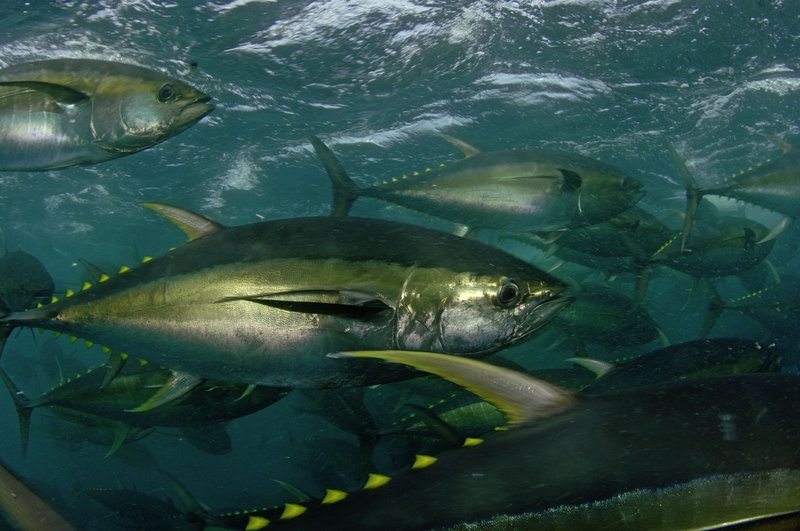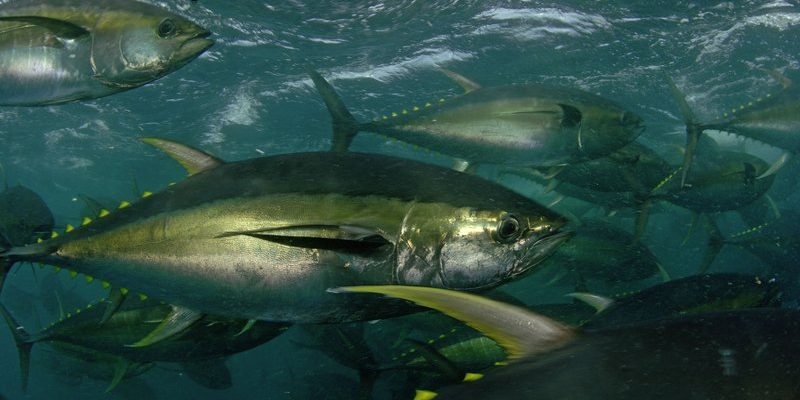
Yellowfin tuna are sleek and powerful swimmers, often gliding through the water with grace. Picture them as the athletes of the sea, zipping around, connecting various parts of the ocean. Their presence affects everything from smaller fish populations to the health of coral reefs, making them essential players in marine ecology. Let me explain how this dynamic creature contributes to its environment and why it matters so much to our oceans.
Understanding the Yellowfin Tuna
Yellowfin tuna, with their striking gold fins and streamlined bodies, are among the most sought-after fish in the world. These fish can grow to impressive sizes, reaching up to 400 pounds! They’re commonly found in warm ocean waters, from the Atlantic to the Pacific. But what makes them so fascinating isn’t just their size; it’s their behavior and role in the food web.
You might be wondering where these fish fit into the ocean’s hierarchy. Yellowfin tuna are considered apex predators. This means they sit near the top of the food chain, primarily feeding on smaller fish like sardines, mackerel, and even squid. By keeping these populations in check, they help maintain a balance among different marine species. Without yellowfin tuna, you could see a surge in these smaller fish, potentially disrupting the ecosystem.
Another interesting fact? Yellowfin tuna are social animals. They often travel in schools, which not only helps them hunt more efficiently but also offers protection against larger predators. This social behavior creates a vibrant community in the ocean and showcases the interconnectedness of marine life.
Impact on Marine Food Webs
Let’s dive a little deeper into the food web. Think of it as a complex network where each species impacts others. Yellowfin tuna play a pivotal role in this network. As skilled hunters, their predation influences the populations of various fish species. When tuna are in healthy numbers, they help control the populations of their prey, ensuring that no one species dominates the ecosystem.
Here’s the thing: if yellowfin tuna populations decline, it can lead to an imbalance. For instance, if there are fewer tuna to keep smaller fish in check, those fish might reproduce rapidly. This overpopulation can lead to overgrazing on plankton and other essential resources, which could eventually harm other marine species. It’s a cascading effect and emphasizes the importance of having healthy tuna populations for the overall health of our oceans.
Additionally, when yellowfin tuna are abundant, they provide food for larger predators, such as sharks and orcas. This connection highlights how removing even a single species from the ecosystem can have far-reaching consequences, affecting everything from individual species to the health of entire ocean regions.
Habitat and Migration Patterns
Yellowfin tuna aren’t just swimming around aimlessly; they have specific habitats and migration patterns that are key to their survival. These fish prefer warm, tropical waters, often found in the upper layers of the ocean. But they’re not static creatures. They migrate long distances in search of food and spawning grounds.
These migrations can stretch thousands of miles! For example, yellowfin tuna spawn in warmer waters, where their offspring can thrive. During their lifecycle, they travel to different depths and areas, proving how adaptable and resilient they are. Unfortunately, human activities, like overfishing and climate change, can disrupt these patterns. You might be surprised to learn that changes in ocean temperatures can affect their spawning and migration, ultimately impacting their population levels.
By understanding their habitat and migration, we can better appreciate why conservation efforts are crucial. Protecting these areas ensures yellowfin tuna can continue their natural life cycles and contribute to the marine ecosystem.
The Economic Importance of Yellowfin Tuna
Beyond their ecological impact, yellowfin tuna hold significant economic value. They are a substantial part of the global fishing industry, and many coastal communities depend on them for their livelihoods. The demand for yellowfin tuna, especially in sushi and sashimi, has skyrocketed over the years, making them a sought-after catch.
However, this popularity comes with challenges. Overfishing is a serious concern, with many populations declining due to unsustainable fishing practices. When yellowfin tuna are overfished, it not only threatens their survival but also the livelihoods of those who rely on them. Honestly, it’s a delicate balancing act between satisfying market demand and ensuring the health of marine ecosystems.
Sustainable fishing practices, like catch limits and protected marine areas, are essential to maintaining healthy tuna populations and supporting local economies. It’s about finding a way to enjoy this tasty fish while still respecting our oceans.
Conservation Efforts for Yellowfin Tuna
With the threats facing yellowfin tuna, various organizations and governments are stepping up conservation efforts. These initiatives aim to ensure that tuna populations remain stable and healthy for future generations.
One of the most effective strategies is implementing sustainable fishing practices. This includes setting quotas to limit how many tuna can be caught each season, ensuring that populations don’t decline too sharply. You might also see movements to promote *catch-and-release* fishing, which allows anglers to enjoy the thrill of fishing without harming the populations.
Additionally, marine protected areas (MPAs) help offer safe spaces for yellowfin tuna and other species. These areas allow fish to spawn and grow without the pressure of fishing, helping to support their populations. The more we understand the importance of yellowfin tuna in our oceans, the more we can advocate for strategies that balance human needs with environmental health.
The Future of Yellowfin Tuna and Our Oceans
Looking ahead, the future of yellowfin tuna — and, by extension, our oceans — depends on our actions today. It’s not just about enjoying a delicious meal; it’s about recognizing that every little decision impacts marine ecosystems. By supporting sustainable fishing practices and conservation efforts, we can protect yellowfin tuna and ensure that they continue to thrive.
You might consider getting involved in local conservation initiatives or even supporting organizations focused on marine life. Every effort counts. Plus, educating others about the importance of yellowfin tuna can help foster a broader understanding and appreciation for our oceans.
As we continue to explore the depths of our seas, let’s remember that yellowfin tuna are more than just fish; they’re vital components of our planet’s health. By cherishing and protecting them, we’re investing in a more sustainable future for marine ecosystems and ourselves.
In summary, the role of yellowfin tuna in marine ecosystems is intricate and vital. They help maintain balance, support other species, and contribute to the economy, but their future is at risk without our collective action. So next time you think about yellowfin tuna, remember the bigger picture and the role we all play in safeguarding our oceans.

